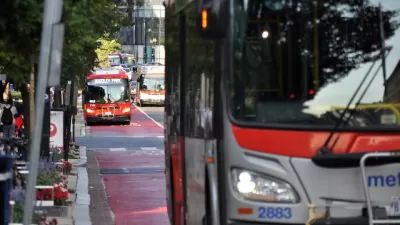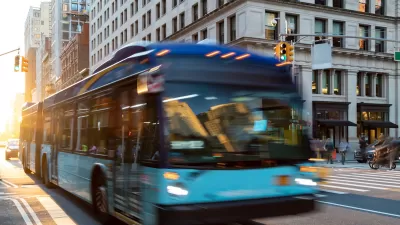Fare capping—putting a ceiling on the amount a transit passenger pays in a day or a month regardless of the number of trips—is becoming a popular policy option for transit agencies seeking to increase equity and bring back riders.

As transit agencies struggle to boost their ridership and adjust to the new realities of transportation in the wake of the COVID-19 pandemic, some advocates are promoting fare capping as one way to support low-income riders and make transit more affordable for frequent travelers.
As Skip Descant explains in Governing, “once a rider pays the equivalency of a monthly pass — whether that takes a week or two — the remaining rides that month are free. Or, once multiple transfers on a given trip reach a certain amount, the rest of the day’s trips are free.”
According to Descant, “Fare capping is seen as not only a key piece of transportation equity but also a way to grow loyalty among riders. And the payment technology — contactless payments, mobile ticketing and other advancements — is making fare capping an easier policy lift for transit organizations.” Christian Henry, senior vice president and general manager, North America eastern region at Cubic Transportation Systems, points out that “In transportation, the convenience of open payments on phones and wearables is helping New York, but the unbanked or those without devices still need the ability to use cash with dignity and have access to the benefits of fare capping through agency-issued fare media.”
The article describes a contactless fare pilot program called the California Integrated Travel Project (Cal-ITP), which “offers technical support to all California transit agencies interested in deploying a contactless fare payment system that includes fare capping.” To date, “As part of Cal-ITP, tap-to-pay systems — which are also fare-capping systems — have been deployed on the Monterey-Salinas Transit system, Santa Barbara Metropolitan Transit District and Sacramento Regional Transit District (SacRT) light rail.”
FULL STORY: One Way to Make Transit More Equitable: Fare Capping

Alabama: Trump Terminates Settlements for Black Communities Harmed By Raw Sewage
Trump deemed the landmark civil rights agreement “illegal DEI and environmental justice policy.”

Planetizen Federal Action Tracker
A weekly monitor of how Trump’s orders and actions are impacting planners and planning in America.

The 120 Year Old Tiny Home Villages That Sheltered San Francisco’s Earthquake Refugees
More than a century ago, San Francisco mobilized to house thousands of residents displaced by the 1906 earthquake. Could their strategy offer a model for the present?

Ken Jennings Launches Transit Web Series
The Jeopardy champ wants you to ride public transit.

BLM To Rescind Public Lands Rule
The change will downgrade conservation, once again putting federal land at risk for mining and other extractive uses.

Indy Neighborhood Group Builds Temporary Multi-Use Path
Community members, aided in part by funding from the city, repurposed a vehicle lane to create a protected bike and pedestrian path for the summer season.
Urban Design for Planners 1: Software Tools
This six-course series explores essential urban design concepts using open source software and equips planners with the tools they need to participate fully in the urban design process.
Planning for Universal Design
Learn the tools for implementing Universal Design in planning regulations.
Clanton & Associates, Inc.
Jessamine County Fiscal Court
Institute for Housing and Urban Development Studies (IHS)
City of Grandview
Harvard GSD Executive Education
Toledo-Lucas County Plan Commissions
Salt Lake City
NYU Wagner Graduate School of Public Service





























